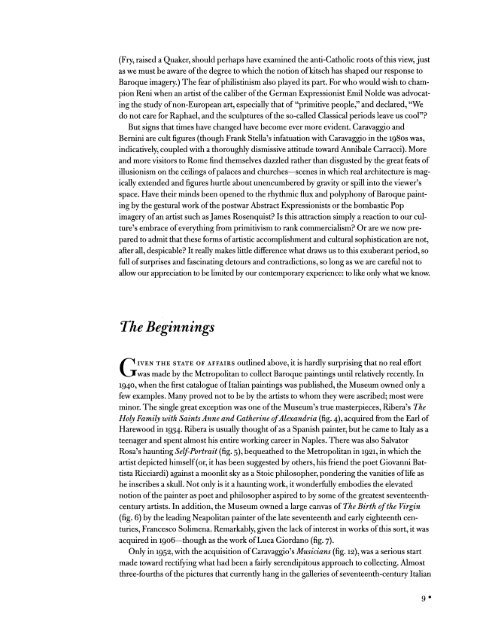GOING FOR BAROQUE Into the Bin - The Metropolitan Museum of Art
GOING FOR BAROQUE Into the Bin - The Metropolitan Museum of Art
GOING FOR BAROQUE Into the Bin - The Metropolitan Museum of Art
Create successful ePaper yourself
Turn your PDF publications into a flip-book with our unique Google optimized e-Paper software.
(Fry, raised a Quaker,<br />
should perhaps<br />
have examined <strong>the</strong> anti-Catholic roots <strong>of</strong> this view, just<br />
as we must be aware <strong>of</strong> <strong>the</strong> degree<br />
to which <strong>the</strong> notion <strong>of</strong> kitsch has our<br />
shaped response to<br />
Baroque imagery.) <strong>The</strong> fear <strong>of</strong> philistinism<br />
also played<br />
its part. For who would wish to cham<br />
pion<br />
Reni when an artist <strong>of</strong> <strong>the</strong> caliber <strong>of</strong> <strong>the</strong> German<br />
Expressionist<br />
Emil Nolde was advocat<br />
ing <strong>the</strong> study<br />
<strong>of</strong> non-European art, especially<br />
that <strong>of</strong> "primitive people,"<br />
and declared, "We<br />
do not care for Raphael,<br />
and <strong>the</strong> sculptures<br />
<strong>of</strong> <strong>the</strong> so-called Classical<br />
periods<br />
leave us cool"?<br />
But<br />
signs<br />
that times have<br />
changed<br />
have become ever more evident.<br />
Caravaggio<br />
and<br />
Bernini are cult<br />
figures (though<br />
Frank Stella's infatuation with<br />
Caravaggio<br />
in <strong>the</strong> 1980s was,<br />
indicatively, coupled<br />
with a thoroughly<br />
dismissive attitude toward Annibale<br />
Carracci).<br />
More<br />
and more visitors to Rome find <strong>the</strong>mselves dazzled ra<strong>the</strong>r than disgusted by<br />
<strong>the</strong> great feats <strong>of</strong><br />
illusionism on <strong>the</strong> ceilings<br />
<strong>of</strong> palaces<br />
and churches?scenes in which real architecture is mag<br />
ically extended and figures hurtle about unencumbered or<br />
by gravity spill<br />
into <strong>the</strong> viewer's<br />
space. Have <strong>the</strong>ir minds been opened<br />
to <strong>the</strong> rhythmic<br />
flux and polyphony<br />
<strong>of</strong> Baroque paint<br />
ing by<br />
<strong>the</strong> gestural<br />
work <strong>of</strong> <strong>the</strong> postwar Abstract<br />
or<br />
Expressionists<br />
<strong>the</strong> bombastic<br />
Pop<br />
imagery<br />
<strong>of</strong> an artist such as James Rosenquist?<br />
Is this attraction<br />
a<br />
simply<br />
reaction to our cul<br />
ture's embrace <strong>of</strong> everything<br />
from primitivism<br />
to rank commercialism? Or are we now<br />
pre<br />
pared<br />
to admit that <strong>the</strong>se forms <strong>of</strong> artistic<br />
accomplishment<br />
and cultural<br />
are<br />
sophistication not,<br />
after all, despicable?<br />
It really<br />
makes little difference what draws us to this exuberant<br />
so<br />
period,<br />
full <strong>of</strong> surprises<br />
and fascinating<br />
detours and contradictions,<br />
so as we are long<br />
careful not to<br />
allow our appreciation<br />
to be limited our by contemporary experience:<br />
to like only<br />
what we know.<br />
<strong>The</strong> Beginnings<br />
Given <strong>the</strong> state <strong>of</strong> affairs outlined above, it is hardly surprising<br />
that no real effort<br />
was made<br />
by<br />
<strong>the</strong> <strong>Metropolitan</strong><br />
to collect Baroque paintings<br />
until<br />
relatively recently.<br />
In<br />
1940, when <strong>the</strong> first catalogue<br />
<strong>of</strong> Italian was<br />
paintings published, <strong>the</strong> <strong>Museum</strong> owned a<br />
only<br />
few examples. Many proved<br />
not to be by<br />
<strong>the</strong> artists to whom<br />
<strong>the</strong>y were ascribed; most were<br />
minor. <strong>The</strong><br />
single great<br />
was one<br />
exception<br />
<strong>of</strong> <strong>the</strong> <strong>Museum</strong>'s true masterpieces,<br />
Ribera's <strong>The</strong><br />
Holy Family<br />
with Saints Anne and Ca<strong>the</strong>rine <strong>of</strong> Alexandria (fig. 4), acquired<br />
from <strong>the</strong> Earl <strong>of</strong><br />
Harewood in 1934. Ribera is usually thought<br />
<strong>of</strong> as a Spanish painter,<br />
but he came to as a Italy<br />
teenager<br />
and spent almost his entire career working<br />
in Naples.<br />
<strong>The</strong>re was also Salvator<br />
Rosa's<br />
haunting Self-Portrait (fig. 5), bequea<strong>the</strong>d<br />
to <strong>the</strong> <strong>Metropolitan</strong><br />
in 1921, in which <strong>the</strong><br />
artist depicted<br />
himself<br />
(or, it has been suggested by o<strong>the</strong>rs, his friend <strong>the</strong> poet Giovanni Bat<br />
tista a Ricciardi) against<br />
moonlit<br />
sky as a Stoic philosopher, pondering<br />
<strong>the</strong> vanities <strong>of</strong> life as<br />
he inscribes a skull. Not<br />
only<br />
is it a haunting work, it wonderfully<br />
embodies <strong>the</strong> elevated<br />
notion <strong>of</strong> <strong>the</strong> as painter poet and philosopher aspired<br />
to some by<br />
<strong>of</strong> <strong>the</strong> greatest seventeenth<br />
century artists. In addition, <strong>the</strong> <strong>Museum</strong> owned a canvas large<br />
<strong>of</strong> <strong>The</strong> Birth <strong>of</strong> <strong>the</strong> Virgin<br />
(fig. 6) by<br />
<strong>the</strong> leading Neapolitan painter<br />
<strong>of</strong> <strong>the</strong> late seventeenth and cen<br />
early eighteenth<br />
turies, Francesco Solimena. Remarkably, given<br />
<strong>the</strong> lack <strong>of</strong> interest in works <strong>of</strong> this sort, it was<br />
acquired<br />
in as 1906?though<br />
<strong>the</strong> work <strong>of</strong> Luca Giordano<br />
(fig. 7).<br />
Only<br />
in 1952, with <strong>the</strong> acquisition<br />
<strong>of</strong> Caravaggio's<br />
Musicians<br />
was a<br />
(fig. 12),<br />
serious start<br />
made toward<br />
rectifying<br />
what had been a fairly serendipitous approach<br />
to collecting.<br />
Almost<br />
three-fourths <strong>of</strong> <strong>the</strong> pictures<br />
that currently hang<br />
in <strong>the</strong> galleries<br />
<strong>of</strong> seventeenth-century<br />
Italian<br />
9*
















